Maintaining high safety standards is crucial when it comes to HVAC installation and construction projects. To ensure the well-being of technicians and prevent accidents, it is essential to be aware of the common safety hazards in the HVAC industry and take appropriate precautions. Additionally, providing personal protective equipment (PPE), following safety procedures, conducting regular inspections, and prioritizing training and education are vital steps in creating a safe working environment.
Key Takeaways:
- Be aware of common safety hazards in the HVAC industry, such as electrical hazards and chemical exposure.
- Wear proper personal protective equipment (PPE), including steel-toed work boots, full-coverage clothing, thick HVAC work gloves, hard hats, safety goggles, face shields, respirators, and earplugs.
- Follow safety procedures and conduct regular inspections to identify and mitigate potential hazards.
- Invest in training and education to enhance technicians’ knowledge and skills in maintaining safety standards.
- Utilize route optimization features in service management software for safer and more efficient HVAC service.
Common Safety Hazards in the HVAC Industry
HVAC installation and construction projects come with various safety hazards that technicians need to be aware of. These hazards can pose risks to the well-being of technicians and can lead to accidents and injuries if proper precautions are not taken. Understanding and addressing these safety hazards is crucial to ensure a safe working environment in the HVAC industry.
Some of the common safety hazards in the HVAC industry include:
- Electrical Hazards: Working with electrical systems and wiring can expose technicians to the risk of electric shock or electrocution. Proper training, grounding techniques, and the use of insulated tools and personal protective equipment (PPE) are essential to minimize these hazards.
- Chemical Exposure: HVAC technicians may come into contact with various chemicals, including refrigerant gases, cleaning solvents, and adhesives, which can be hazardous if not handled correctly. Proper ventilation, the use of appropriate PPE, and adherence to safety protocols can help prevent chemical-related accidents and health issues.
- Inadequate Equipment Inventory: Insufficient or faulty equipment can increase the risk of accidents and injuries. Regular maintenance, inspections, and ensuring technicians have access to the right tools and equipment are vital to mitigate these hazards.
- Respiratory Hazards: HVAC technicians may encounter respiratory hazards such as dust, mold, and harmful particulates. Proper respiratory protection, including the use of respirators and masks, is essential to prevent respiratory illnesses and long-term health issues.
- Ladder Liability: Working at heights is a common requirement in HVAC projects, and improper ladder use can lead to falls and severe injuries. Training technicians on ladder safety, ensuring stable footing, and using fall protection equipment can help prevent ladder-related accidents.
- Dangerous Driving: Technicians often need to travel between job sites, and unsafe driving practices can lead to accidents and injuries. Safe driving training, adherence to traffic rules, and implementing route optimization features can improve driver safety and reduce the risk of accidents.
- Unprofessional Conduct: Poor communication, lack of coordination, and unprofessional behavior can create safety hazards on HVAC projects. Promoting a culture of professionalism, teamwork, and open communication is essential to minimize these risks.
- Extreme Weather: HVAC technicians may be exposed to extreme weather conditions while working outdoors. Proper planning, monitoring weather forecasts, and providing adequate protective gear are necessary to mitigate the risks associated with extreme weather.
- Technician and Client Health: In addition to their own safety, HVAC technicians must also consider the health and safety of their clients. Ensuring proper ventilation, minimizing exposure to allergens and pathogens, and following industry guidelines for maintaining indoor air quality can help protect both technicians and clients.
By understanding and addressing these common safety hazards, HVAC businesses can create a safer working environment, protect their technicians, and provide high-quality service to their clients.
| Common Safety Hazards | Precautions |
|---|---|
| Electrical Hazards | Proper training, grounding techniques, insulated tools, and PPE |
| Chemical Exposure | Proper ventilation, PPE, and adherence to safety protocols |
| Inadequate Equipment Inventory | Regular maintenance, inspections, and access to the right tools and equipment |
| Respiratory Hazards | Respiratory protection, including respirators and masks |
| Ladder Liability | Ladder safety training, stable footing, and fall protection equipment |
| Dangerous Driving | Safe driving practices, adherence to traffic rules, and route optimization |
| Unprofessional Conduct | Culture of professionalism, teamwork, and open communication |
| Extreme Weather | Proper planning, monitoring weather forecasts, and protective gear |
| Technician and Client Health | Proper ventilation, minimizing exposure, and maintaining indoor air quality |
By implementing these safety precautions and creating a strong safety culture, HVAC businesses can prioritize the well-being of their technicians, enhance service quality, gain customer trust, and differentiate themselves in the industry.
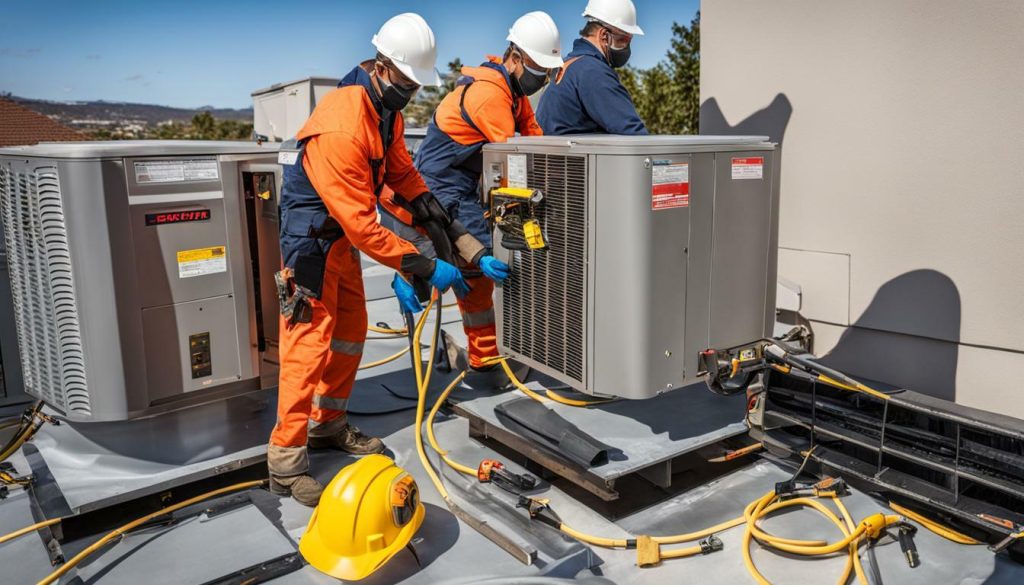
Personal Protective Equipment (PPE) for HVAC Safety
Wearing the appropriate personal protective equipment (PPE) is crucial for HVAC technicians to minimize the risk of accidents. By using the right PPE, technicians can protect themselves from potential hazards and ensure a safe working environment. Here are some essential pieces of equipment that HVAC technicians should wear:
- Steel-toed work boots: These sturdy boots provide protection for the feet from heavy objects or electrical hazards.
- Full-coverage clothing: Wearing clothing that covers the entire body prevents exposure to chemicals, sparks, or other potential dangers.
- Thick HVAC work gloves: Gloves with reinforced palms and fingers protect against cuts, burns, and chemical exposure.
- Hard hats: A hard hat shields the head from falling objects or bumps in confined spaces.
- Safety goggles: Goggles protect the eyes from debris, chemicals, or any other foreign objects.
- Face shields: When working with chemicals or potential facial hazards, face shields provide additional protection for the face and eyes.
- Respirators: Depending on the nature of the job, respirators filter out harmful particles or chemicals, ensuring clean and safe air to breathe.
- Earplugs: Noise protection is important in an HVAC environment, so earplugs can help reduce the risk of hearing damage from loud machinery or equipment.
It’s important for HVAC technicians to wear PPE consistently and correctly. They should also regularly inspect their equipment for any signs of wear and tear, replacing or repairing it as necessary. By prioritizing the use of proper PPE, technicians can significantly reduce the likelihood of accidents or injuries on HVAC installation and construction projects.
Importance of Personal Protective Equipment (PPE)
Using personal protective equipment (PPE) is not just a good practice, but it’s also a legal requirement in many jurisdictions. Employers have a responsibility to provide the necessary PPE to their technicians and ensure its proper use. By doing so, they can create a safer work environment and reduce the risk of incidents.
Wearing the right PPE not only protects technicians from immediate hazards but also guards against long-term health issues. For example, respiratory masks protect against harmful particles and chemicals that can cause respiratory illnesses. Additionally, proper eye protection prevents eye injuries that could have long-lasting effects.
| PPE Item | Purpose |
|---|---|
| Steel-toed work boots | Protect feet from heavy objects or electrical hazards |
| Full-coverage clothing | Prevent exposure to chemicals, sparks, or other potential dangers |
| Thick HVAC work gloves | Protect against cuts, burns, and chemical exposure |
| Hard hats | Shield the head from falling objects or bumps in confined spaces |
| Safety goggles | Protect the eyes from debris, chemicals, or any other foreign objects |
| Face shields | Provide additional protection for the face and eyes when working with chemicals or potential facial hazards |
| Respirators | Filter out harmful particles or chemicals, ensuring clean and safe air to breathe |
| Earplugs | Reduce the risk of hearing damage from loud machinery or equipment |
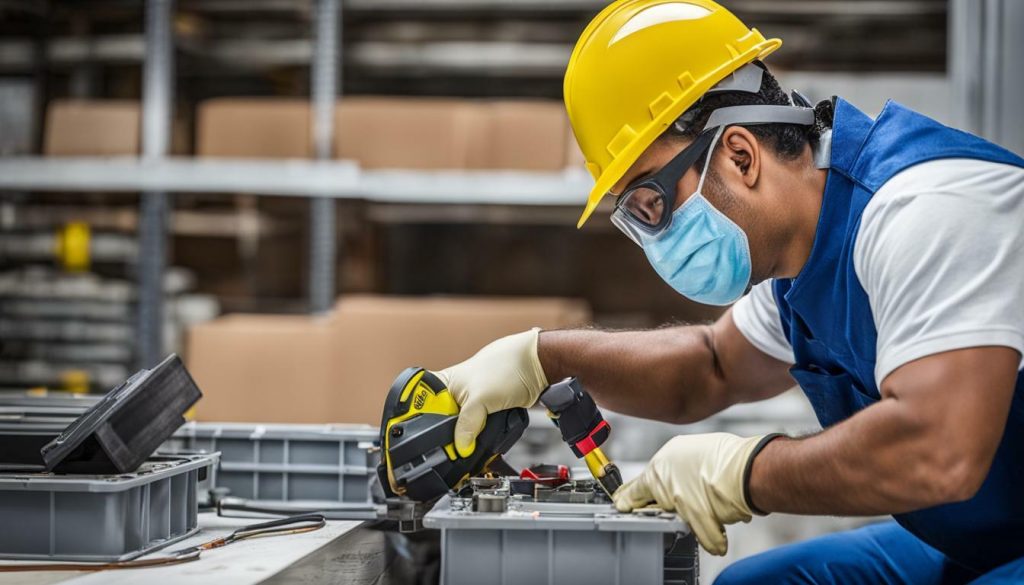
Investing in high-quality PPE and providing proper training on its usage demonstrates a commitment to technician safety. By prioritizing the use of PPE and ensuring its availability and maintenance, HVAC businesses can foster a culture of safety and protect their technicians from potential harm on the job.
Safety Procedures and Inspections for HVAC Projects
Implementing and enforcing safety procedures, as well as conducting regular inspections, is essential to ensure a safe working environment on HVAC projects. By prioritizing safety, HVAC businesses can protect their technicians, improve service quality, gain customer trust, and differentiate themselves from competitors. Safety should be an integral part of every project, from the initial planning stages to the final completion.
One of the key aspects of safety procedures is proper planning. This includes identifying potential hazards, assessing risks, and developing strategies to mitigate them. By addressing safety concerns proactively, technicians can minimize the likelihood of accidents and injuries on the job. It is also important to strictly adhere to safety guidelines and regulations, ensuring that all work is performed in accordance with industry standards.
Regular inspections are crucial in identifying potential hazards and ensuring compliance with safety protocols. These inspections should be conducted at various stages of the project, including during installation, maintenance, and repairs. Inspections can help detect faulty equipment, inadequate safety practices, or any potential risks that may arise. By addressing these issues promptly, technicians can prevent accidents and maintain a safe working environment.
| Benefits of Safety Procedures and Inspections on HVAC Projects |
|---|
| Minimize the risk of accidents and injuries |
| Protect technicians and clients |
| Ensure compliance with safety regulations |
| Enhance service quality and customer trust |
| Identify and address potential hazards |
Overall, incorporating robust safety procedures and conducting regular inspections are vital steps in promoting a culture of safety within HVAC businesses. By focusing on the well-being of technicians and prioritizing safety at all times, HVAC companies can achieve successful project outcomes while minimizing risks and liabilities.
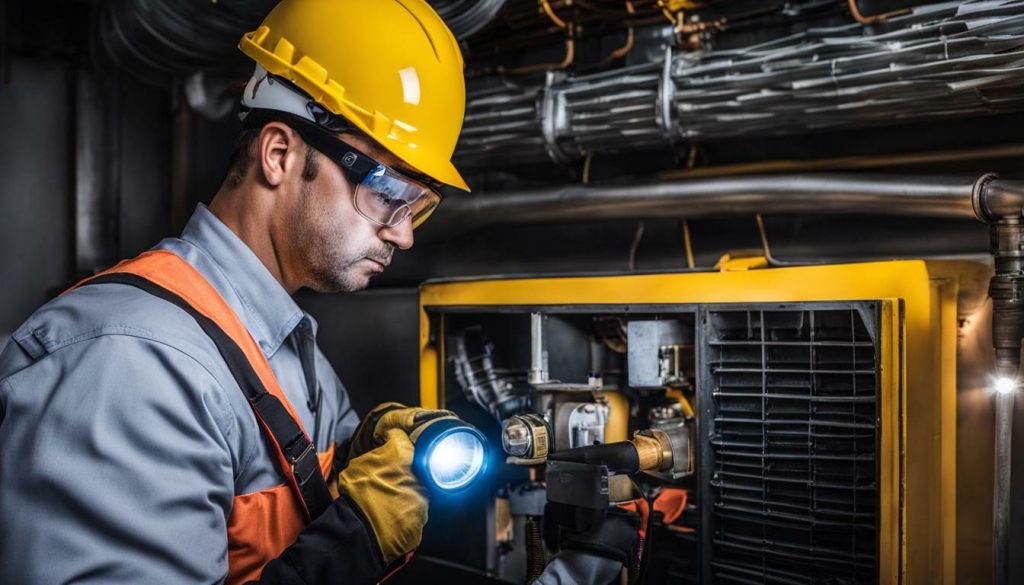
Training and Education for HVAC Safety
Proper training and education play a vital role in promoting HVAC safety and preventing accidents. With the complex nature of HVAC installation and construction projects, it is essential for technicians to have a solid foundation of knowledge and skills to navigate potential hazards effectively.
One of the key aspects of HVAC safety training is providing technicians with comprehensive understanding of safety protocols. This includes instruction on proper handling of tools and equipment, electrical safety procedures, chemical handling guidelines, and adherence to industry-specific safety standards. By equipping technicians with this knowledge, businesses can minimize the risk of accidents and ensure a safe working environment.
Benefits of HVAC Safety Training and Education:
1. Accurate Risk Assessment: Proper training enables technicians to identify potential safety hazards on HVAC projects, allowing for proactive risk assessment and mitigation.
2. Enhanced Safety Consciousness: Education fosters a safety-conscious mindset among technicians, encouraging them to consistently prioritize safety in their work practices.
3. Compliance with Regulations: Rigorous training ensures compliance with safety regulations and standards, reducing the risk of legal liabilities for HVAC businesses.
| Types of HVAC Safety Training | Benefits |
|---|---|
| Basic Safety Training | Introductory training covering fundamental safety practices and guidelines. |
| Advanced Safety Training | Detailed training on handling complex HVAC systems and addressing specific safety challenges. |
| Continuous Professional Development | Ongoing training and education to keep technicians updated with the latest safety protocols and best practices. |
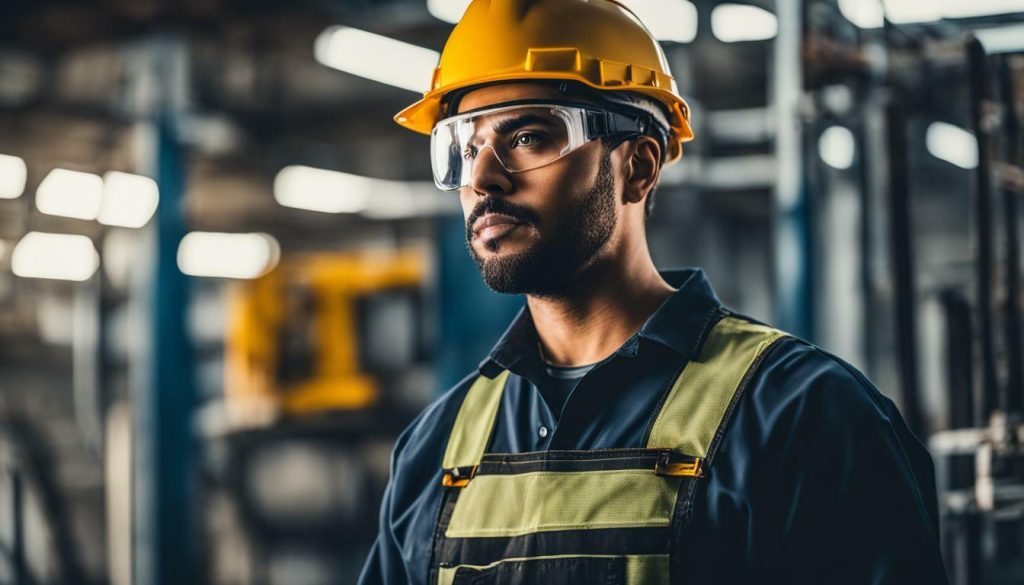
Implementing regular safety training programs and encouraging continuous professional development not only promotes a safer work environment but also enhances the overall quality of HVAC services provided. By investing in training and education, HVAC businesses can instill a culture of safety, protect their technicians, gain customer trust, and differentiate themselves in the competitive market.
Route Optimization for Safe and Efficient HVAC Service
Incorporating route optimization features in service management software can enhance HVAC technicians’ safety and productivity. By leveraging advanced algorithms and real-time data, this technology helps create the most efficient routes for technicians to travel between job sites, reducing driving risks and improving overall service delivery.
With route optimization, technicians can avoid congested areas, roadworks, and high-traffic periods, minimizing the chances of accidents and delays. By optimizing the routes, technicians can also reduce their travel time, allowing them to attend to more service calls in a day and improving their productivity.
Furthermore, this technology allows HVAC businesses to proactively assess the safety of the chosen routes. By considering factors such as weather conditions and road conditions, technicians can avoid areas that may pose potential risks, ensuring their safety on the road.
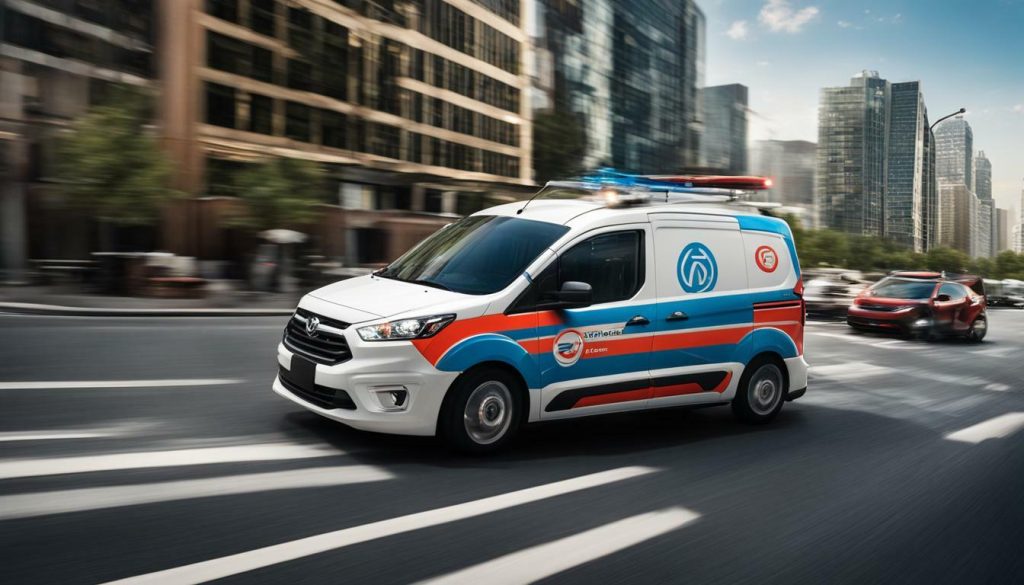
Overall, route optimization plays a crucial role in ensuring the safety and efficiency of HVAC service. By maximizing the use of service management software’s route optimization features, HVAC businesses can protect their technicians, provide prompt service to customers, and stay ahead of the competition.
The Importance of Safety Culture in HVAC Businesses
Establishing a robust safety culture is paramount for HVAC businesses to prioritize technician safety and achieve overall success. A strong safety culture demonstrates a commitment to maintaining a safe working environment, minimizing accidents, and protecting the well-being of technicians. By emphasizing safety as a core value, HVAC businesses can instill a sense of responsibility and awareness among their technicians, ensuring that safety protocols are followed diligently.
To cultivate a safety culture, HVAC businesses should provide comprehensive training and education programs to equip technicians with the knowledge and skills necessary to identify and mitigate potential hazards. Regular safety meetings and workshops can further reinforce the importance of safety and keep technicians updated on best practices. Encouraging open communication channels where technicians can report safety concerns or near misses without fear of retribution is also crucial for creating a culture of safety.
In addition to training and communication, HVAC businesses should actively promote the use of personal protective equipment (PPE) among their technicians. This includes providing the necessary equipment, such as steel-toed work boots, full-coverage clothing, thick HVAC work gloves, hard hats, safety goggles, face shields, respirators, and earplugs. By ensuring that technicians have access to the appropriate PPE, businesses can significantly reduce the risk of accidents and injuries on the job.
The Benefits of a Safety Culture in HVAC Businesses
A strong safety culture offers numerous benefits to HVAC businesses. First and foremost, it helps protect technicians from harm, reducing the number of accidents and injuries. This not only safeguards their well-being but also ensures their continued productivity and contribution to the business.
Furthermore, prioritizing safety demonstrates a commitment to quality service and professionalism. Customers are more likely to trust businesses that prioritize their technicians’ safety and are more willing to engage their services. This can lead to increased client satisfaction, word-of-mouth referrals, and ultimately, business growth.
Lastly, a safety culture gives HVAC businesses a competitive edge in the industry. By differentiating themselves as leaders in safety standards, businesses can attract top talent and stand out from competitors who may not prioritize technician safety. This can contribute to employee retention and the overall reputation and success of the business.
| Benefits of a Safety Culture in HVAC Businesses |
|---|
| Protects technicians from harm |
| Increases client trust and satisfaction |
| Offers a competitive edge in the industry |
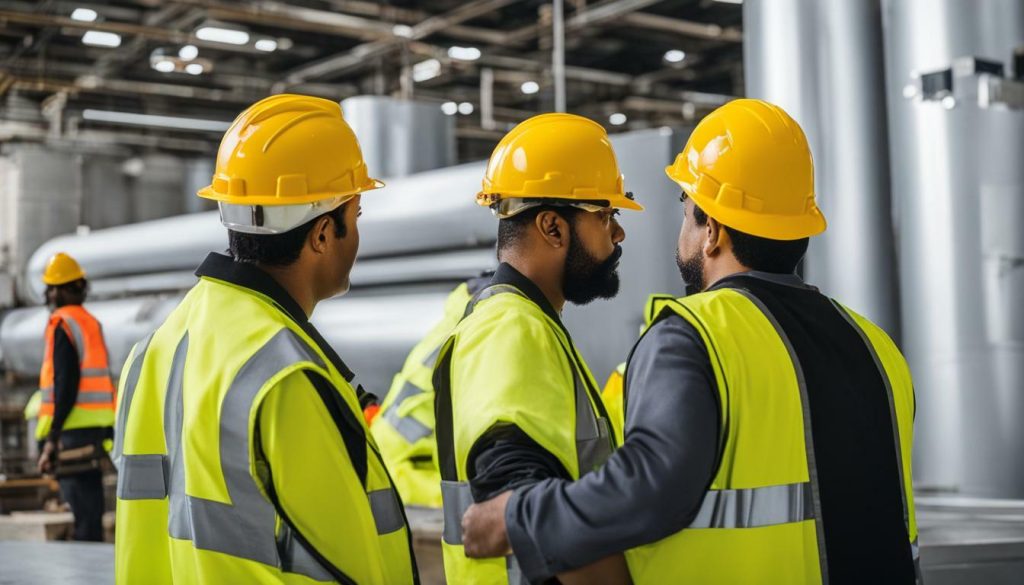
Extreme Weather Preparedness in HVAC Projects
Being prepared for extreme weather conditions is crucial for maintaining HVAC project safety. Extreme weather events such as hurricanes, blizzards, and heatwaves can pose significant risks to technicians and clients alike. By implementing proper precautions and following safety guidelines, HVAC businesses can minimize potential hazards and ensure the well-being of their workforce.
To effectively prepare for extreme weather, it is essential to have a comprehensive plan in place. This plan should include procedures for monitoring weather forecasts, assessing the potential impact on ongoing projects, and making informed decisions regarding work schedules and site evacuations, if necessary. By staying ahead of the weather and having a clear plan of action, HVAC businesses can significantly reduce the risks posed by extreme weather events.
Another crucial aspect of extreme weather preparedness is ensuring that technicians have the necessary equipment and protective gear. This includes appropriate clothing for varying weather conditions, such as insulated outerwear for cold temperatures or lightweight, breathable clothing for extreme heat. Additionally, technicians should be equipped with safety harnesses and fall protection gear when working at heights, especially during high winds or storms.
| Extreme Weather Hazards | Precautions |
|---|---|
| High winds | Secure equipment and materials, and avoid working at heights or in exposed areas |
| Heavy rain and floods | Ensure proper drainage and avoid working in areas prone to flooding |
| Severe heat | Provide ample water and frequent breaks in shaded areas, and wear lightweight, breathable clothing |
| Extreme cold | Use insulating materials and provide heated shelter for technicians |
| Thunderstorms and lightning | Take shelter indoors and avoid working with electrical equipment |
In addition to these measures, regular safety training and communication are crucial for HVAC businesses to ensure that technicians understand and follow the established protocols during extreme weather events. By emphasizing the importance of safety and providing ongoing education, businesses can empower their workforce to make informed decisions and prioritize their own well-being.
Conclusion
Prioritizing HVAC safety is imperative for successful installation and construction projects, and by following the guidelines and tips outlined in this article,
you can ensure a safe working environment for your HVAC technicians. The importance of safety on HVAC projects cannot be overstated, as accidents can lead to injuries, delays, and costly damages.
Common hazards in the HVAC industry include electrical hazards, chemical exposure, inadequate equipment inventory, respiratory hazards, ladder liability, dangerous driving, unprofessional conduct, extreme weather, and risks to technician and client health. To mitigate these risks, technicians should always wear personal protective equipment (PPE) such as steel-toed work boots, full-coverage clothing, thick HVAC work gloves, hard hats, safety goggles, face shields, respirators, and earplugs.
In addition to proper PPE, it is crucial to follow safety procedures, conduct regular inspections, and provide comprehensive training and education to HVAC technicians. These measures help maintain a safe working environment and enable technicians to identify and mitigate potential hazards effectively.
Moreover, employing route optimization features in service management software can help minimize driving risks and ensure efficient HVAC service. Optimized routes not only save time and fuel but also contribute to overall technician safety by reducing the chances of accidents and providing timely arrival at job sites.
Finally, cultivating a strong safety culture within your HVAC business is essential. Prioritizing safety not only protects your technicians but also improves service quality, builds customer trust, and differentiates your business from competitors. By implementing the safety guidelines and checklist discussed in this article, you can elevate your safety standards and create a work environment where your technicians can thrive and deliver exceptional HVAC services.
FAQ
What are some common safety hazards in the HVAC industry?
Common safety hazards in the HVAC industry include electrical hazards, chemical exposure, inadequate equipment inventory, respiratory hazards, ladder liability, dangerous driving, unprofessional conduct, extreme weather, and technician and client health.
What personal protective equipment (PPE) should HVAC technicians wear?
HVAC technicians should wear steel-toed work boots, full-coverage clothing, thick HVAC work gloves, hard hats, safety goggles, face shields, respirators, and earplugs to protect themselves from potential accidents.
Why is it important to follow safety procedures and conduct regular inspections on HVAC projects?
Following safety procedures and conducting regular inspections is crucial to identify potential hazards and mitigate risks on HVAC projects. It helps in maintaining a safe working environment for technicians and preventing accidents.
What is the significance of training and education regarding HVAC safety?
Providing adequate training and education to HVAC technicians enhances their knowledge and skills in maintaining safety standards. It ensures that they are equipped with the necessary information to prioritize safety on job sites.
How can route optimization contribute to safe and efficient HVAC service?
Employing route optimization features in service management software helps technicians minimize driving risks and ensure timely arrival at job sites. It enables them to plan their routes efficiently and avoid potential hazards on the road.
Why is it important for HVAC businesses to prioritize safety culture?
Prioritizing safety culture within HVAC businesses protects technicians, improves service quality, gains customer trust, and differentiates businesses from competitors. It creates a working environment that values the well-being and safety of all individuals involved.
How can HVAC businesses prepare for extreme weather conditions during projects?
HVAC businesses should be prepared for extreme weather conditions during projects by implementing appropriate safety measures. This includes monitoring weather forecasts, having emergency plans in place, and providing proper protective gear and precautions to technicians and clients.

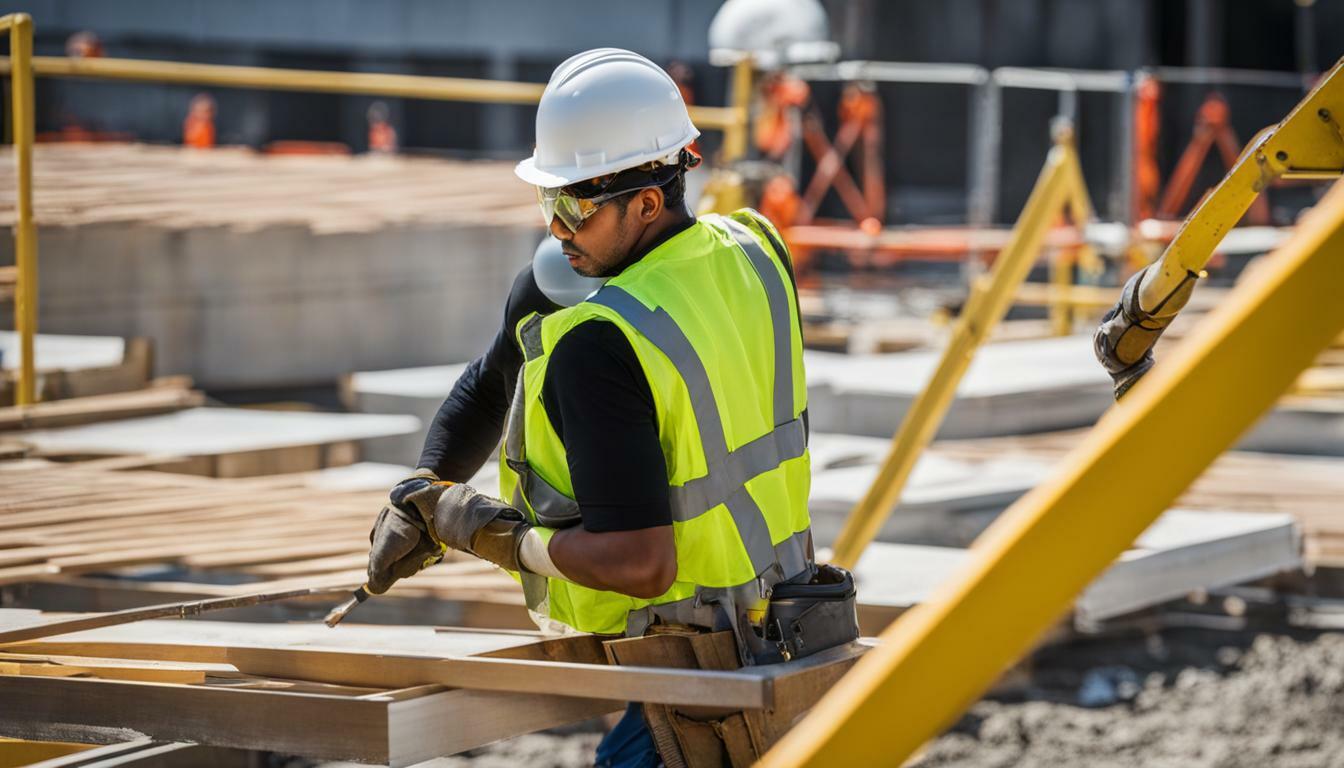



0 Comments